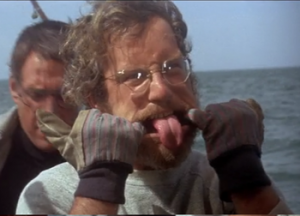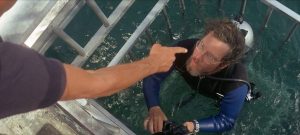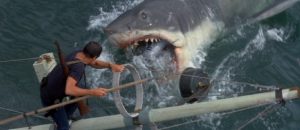
![]()
Yesterday, Saturday, we went to Willingham auctions, got the Xmas tree down from the loft and set it up, and – as well my doing a little bit of model-making – watched a ton of TV. An episode of Poirot, an old black and white Hammer horror film (Nightmare, 1963), sundry other titbits (including most of The Island, 2005), and then finally, that toothy, bloody saltwater classic, Jaws.
I probably first saw this film in the mid ’80s. At that tender age (10-12 ‘ish) it had quite an impact, and I was rather put off the idea of swimming in the sea. Not that we ever got to any shark-infested waters; the muddy North Sea off Southwold was about it.
Over the years I must’ve seen it four or five times now. It’s become a veg-out staple. Despite repeated viewings I’m still always surprised at how the movie starts, with the kids at the beach round a campfire, drinking and playing music, etc.


The first kill is a classic; a beautiful naked young chick, Chrissy, from the beach party. In some strange and sinister way this scene touches upon the fascination we have with serial killers, perhaps of the Ted Bundy type, stalking young beauties before dispatching them with cold-blooded brutality.
Chrissy’s drunk/stoned male companion is oblivious, thanks to his stupor and the crashing surf, to her cries of distress. And we see her from both the attacking predators point of view, as Jaws approaches her from below, and also dragged about, as sharks do when they play with their catches, on the surface.


The juxtaposition of the peaceful seaside, youngsters partying, and a nubile young beauty, with this cold ‘motiveless’ killing is very effective. Once again, the mid ’70s zeitgeist might suggest a connection with such then notorious serial-killers as …
The young male, a student on vacation, reports his companions’ disappearance, and police chief Brody (Roy Scheider) is called from the small humdrum concerns of the quiet coastal resort of Amity, to find his deputy at the beach, where a gruesome discovery has been made.

Apart from it being a well-structured and well-crafted intro to a film, with the twin lures of sex and death acting like ‘chum’ on the hungry audience, there’s also John William’s brilliantly menacing score. The driving bass ostinato has passed into our collective cultural consciousness as a shorthand for the approach of cold, relentless brutality.

The cast are excellent, with Roy Scheider exactly right as the harassed, put-upon and slightly uncomfortable new man on the job, police chief Brody. Robert Shaw is Quint, salty old sea-dog with a special hatred for sharks, as a survivor of a shark feeding frenzy during the sinking of USS Indianapolis [1]. Richard Dreyfuss’ Hooper, a rich-kid college boy shark expert, completes the trio who will ultimately hunt the great white wha… er, sorry… shark! [2]



The first half of the film concerns how Brody will handle the shark attacks, what with the local mayor – Larry Vaughan (Murray Hamilton) – and businesses desirous that their 4th of July tourist trade and summer season business isn’t disrupted by a shark panic.

Not long after Chrissy’s death, a young boy swimming on a li-lo at a crowded beach becomes victim #2. And when victim #3, a grown man in a boat, is munched up, just yards from one of Brody’s own kids… well, something’s got to give.
So Brody convinces Mayor Vaughan to bankroll Quint, who’s already offered his services as aquatic pest control. The film then shifts from the community in panic segment, to the hunt, with Brody and Hooper accompanying Quint on an aquatic safari to blue hell.

What starts out as a ripsnorting boys’ own adventure on the high seas, soon degenerates into a war of attrition. A war that’s being won, far from the terra firma of shore, by a gurt big fish in his element, terror aqua.


After Quint’s methods fail, they try out Hooper’s tactics. But once agin, that devious dirty great white outwits them. Until, finally, Brody faces the beast, alone.


Familiarity breeds relaxation. It’s not easy to recall how terrifying this all was, on first viewing, all those years ago. But one things for sure: Jaws is a summer-blockbusting celluloid classic, chock-full of all the right ingredients for a breathless edge of your seat Saturday matinee, be it at the cinema, or on heavy rotation on the TV, ever since.

One could easily read a lot into numerous aspects of this film, and people frequently do. Indeed, it’s part of the films enduring charm and success, that it can be a kind of cinematic palimpsest, over which we write our own interpretations. Whatever it might really be all about, whether it be profound or just plain ol’ fashioned entertainment, you know a film has really sunk into the collective consciousness when it’s parodied, quoted and otherwise reprocessed.


And as well as the parodies, there was also the associated merchandising, and the several sequels. Jaws was one of the first films of its kind to be released with really hefty marketing, including many associated merchandising lines, such as the dolls below.

There are many things about Jaws to love or enjoy. But one thing I think is less good is its impact on the film industry as a business. The biggest grossing movie of all time until Star Wars, it set a benchmark for the thrill ‘n’spills style summer blockbuster.
And like Star Wars, or the Indiana Jones movies, or whatever, as good as they may be in themselves, they’ve helped usher in an era of dumbing down in pursuit of big bucks. This not only lowers the quality of the mainstream itself, but also, by helping turn the mainstream into an all encompassing juggernaut, shoves aside and marginalises other perhaps more interesting stuff.
NOTES:

[1] The sinking of the Indianapolis is a real event, as indeed were the subsequent shark attacks on the men who awaited rescue. These men, or rather some of these men, survived four days adrift at sea before being rescued. According to my quick glance around the interweb, only a little over 300 of the 1,200 aboard at the time of the disaster survived. Most died of injuries sustained in the torpedoing and subsequent explosions, or by drowning, starving, or drinking seawater, etc. What proportion were killed by sharks – and the sharks feasted on the dead as well as the living – isn’t made clear anywhere I can find. But one can certainly believe any survivors might well hate sharks!
[2] Surely there has to be a connection of some sort between Moby Dick and Jaws? Both embody a relentless battle between a Leviathan of the deeps and man.
